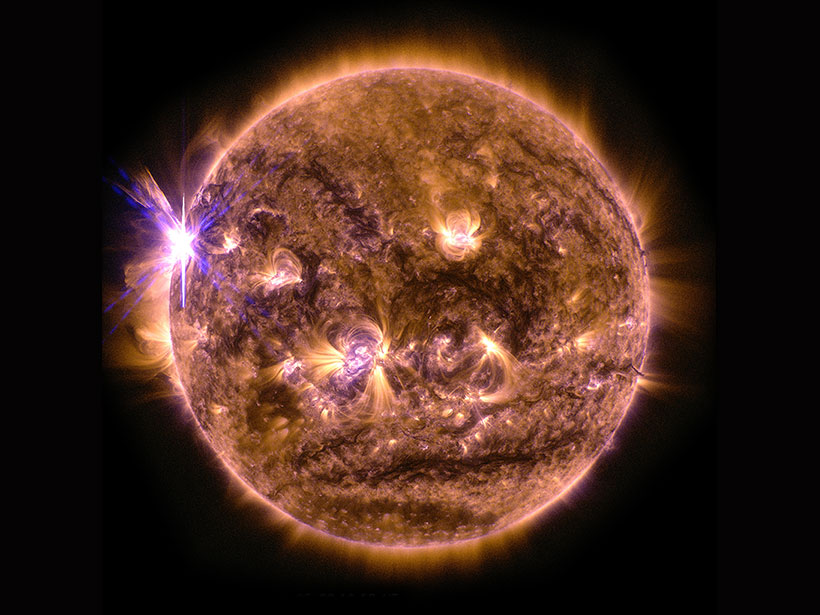On 5 May, the Sun unleashed a large solar flare—the biggest of the year. Amateur radio operators in the Pacific Ocean heard the effects as a burst of noise, as electrons hurtling through the Sun’s atmosphere generated high-frequency plasma waves that propagated toward Earth.
Most solar flares—bright flashes that accompany solar magnetic explosions—are harmless. However, the 5 May flare was accompanied by a coronal mass ejection (CME)—a huge magnetic cloud of turbulent, roiling plasma that accelerates the radiation of charged particles. When CMEs collide with the Earth’s magnetosphere, they can wreak havoc on communications and navigation systems, short out satellite circuits, and damage electric grids on the ground.
Luckily, the 5 May CME only grazed Earth’s magnetosphere. However, if a very large CME were to directly hit Earth, “it could cause widespread disruption to critical technological infrastructure,” said Tom Berger, director of the National Oceanic and Atmospheric Administration’s Space Weather Prediction Center.
“As a nation, we are not prepared to sustain an extreme space weather event.”
“I would argue that currently, as a nation, we are not prepared to sustain an extreme space weather event,” said Berger.
In response to this unpreparedness, the National Science and Technology Council’s Space Weather Operations, Research, and Mitigation Task Force released a draft of a National Space Weather Strategy on 29 April. The document, which lays out ways in which the nation can better prepare for a future space weather event, is now open for public comment.
Effects of a Geomagnetic Storm
When the Sun belches out a CME, it can potentially interact with Earth’s magnetic field in disastrous ways, disrupting communications and rendering GPS systems unusable. Electrical currents in the Earth driven by the CME could travel into the power grid and damage transformers, potentially causing regional power shortages or even blackouts for days or weeks.
A prolonged power outage can be fatal. In 2003, a series of electric grid failures led to a 2-day blackout in New York. During this time, thousands of people were left without potable water or access to food. Hospitals—many of them without power themselves—became overwhelmed with people seeking medical attention or electricity. At least six deaths were attributed directly to the power outage.
If an extreme geomagnetic storm were to hit Earth, the effects on the power grid could be catastrophic, Berger explained. He added that if the nation is not prepared to mitigate the effects of an extreme event, large regions of the country’s power grid could be destabilized and possibly blacked out.
“This would be equivalent to having several hurricanes come ashore across the East coast at the same time, in terms of the wide spread damage it could cause to the grid,” Berger said.
The National Strategy
In 2008, the National Academy of Sciences released a report detailing how a geomagnetic storm would affect Earth—but there was no recommended strategy for how the nation could respond or mitigate damage, Berger said. This new national strategy does just that.
The strategy focuses on three key areas: enhancing operational forecasting, improving research to better understand space weather events, and developing plans to mitigate damage during and following such an event.
Among its many proposals, the strategy calls for enhancing recovery capabilities by establishing power grid recovery plans, improving communications systems between forecasters and emergency managers, and developing protocols to provide guidance and support before, during, and after an extreme space weather event.
Another major section of the new strategy calls for better observational and forecasting capabilities, which comes down to a better understanding of space weather and the Sun itself—something that requires more basic research and observational instruments, Berger said.
Only one satellite exists that directly observes the Sun’s eruptions using an instrument called a coronagraph, and it is 20 years old.
Currently, researchers have no way of understanding how the Sun even produces magnetic eruptions or how the eruptions propagate through space and interact with the Earth’s magnetic field, Berger said. Furthermore, he explained that scientists lack the equipment to improve this understanding.
For example, although NASA has several missions monitoring space weather and investigating the interactions between solar wind and Earth’s magnetosphere, only one satellite exists that directly observes the Sun’s eruptions using an instrument called a coronagraph—and it is 20 years old. Data from this satellite can sometimes take hours to download, Berger said.
Looking Ahead
The strategy also proposes setting benchmarks for policy makers and electrical workers, such as how much radiation, ionosphere disturbance, and electricity surging could be expected from a CME.
“Ideally, this national strategy will be the nucleus around which the next decade of activity in space weather research, operations, and mitigations can coalesce to get us to a point where 10 years from now we can say, definitively, ‘we are ready’” if an extreme CME comes our way, Berger said.
The National Space and Technology Council is accepting comments until 29 May.
—JoAnna Wendel, Staff Writer
Citation: Wendel, J. (2015), Protecting Earth from solar storms, Eos, 96, doi:10.1029/2015EO029633. Published on 13 May 2015.
Text © 2015. The authors. CC BY-NC 3.0
Except where otherwise noted, images are subject to copyright. Any reuse without express permission from the copyright owner is prohibited.

